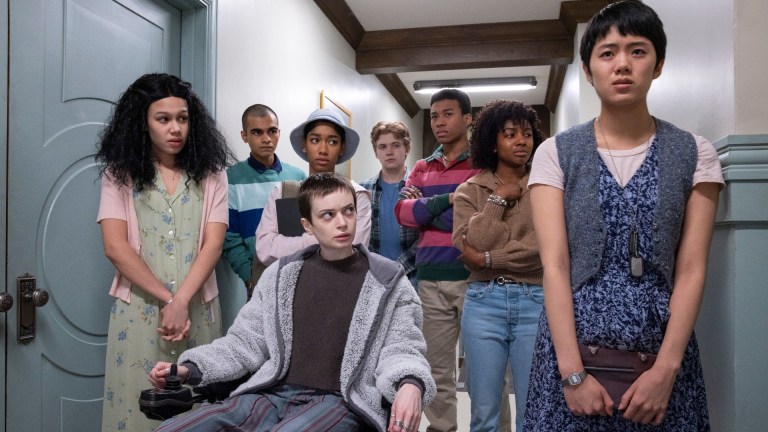What The Midnight Club Gets Right About Hospice Care
In addition to its spooky pedigree, Netflix's The Midnight Club understand the compassion necessary for end-of-life care.

You’d think watching a television series about hospice as I gave end-of-life care to my dad would be a horrible idea. But I craved the familiar company of ghosts.
However, Mike Flanagan and Leah Fong’s The Midnight Club provided me with something else – the understanding I needed to put another morphine syringe into my father’s blistering mouth. What appeared on-screen mirrored what was unfolding in my home, which, yes, gave validation to how unbelievably hard this is. The writing whispered permission for me (like the show’s teens) to feel a range of conflicting emotions at the prospect of letting someone die on their terms … including relief.
But vitally, it reminded me that this is what he wanted. As volatile as my feelings were, this is a time to comfort him, to feel the warmth between our hands for as long as it lasts. For that and more, The Midnight Club deserves immense praise for how it handles navigating a series about terminally ill teens processing their diagnosis and managing others’ expectations that come with that ill-fated news.
At 33, most of my peers haven’t had to lose a parent to Alzheimer’s Disease. Watching the cognitive parts of them slip away is tough, sure, but even harder than that is seeing their skin tissue, nails, and the color of their eyes break down as if to say: Enough. This being no longer remembers nor wants to keep itself together. The human transforms into the coldest phrase: a body.
When this happens, It’s easy to fall on platitudes to say like the “fight” is over – as if those who were sick didn’t do enough or weren’t strong enough to survive it. Off the bat, The Midnight Club kicks this phrasing right in its teeth. When we meet Brightcliffe Home hospice owner Dr. Georgina Stanton (Heather Langenkamp), she tells the viewer how insulting this language is. No one conquers death.
A similar speech was told to me when I met my father’s hospice nurse. She said, “It’s funny, we put so much energy into celebrating life, but we don’t give death the same attention.” Much of The Midnight Club’s horror comes from the interiority of its characters. No, there’s no Bent-Neck Lady chasing our cast or specters looming in background shots. Instead, we experience it through what these teens endure and the stories they tell. To feel that fear for them and with them, we need to see the most vibrant versions of them. (Hey, which of us hasn’t pretended to be the star of a noir murder mystery?)
Adapting Christopher Pike’s work is no easy task, but Fong and Flanagan use the book’s premise – dying teens telling each other’s scary stories to feel better – to unlock deeper dimensions into who these people are. That’s the celebration that rang true. How can a viewer say goodbye to someone if they don’t know who they are? How can anyone? In death, we need to honor life. Within all these stories these teens tell, they hide nuggets of their deepest regrets – like Anya’s (Ruth Codd) betrayal of her best friend – desires and treasured thoughts.
In general, hospice stresses making your loved one comfortable and talking to them. For me, it was a lot of hand-holding and listening to Frank Sinatra – whether or not he could hear it or necessarily knew I was there. Sometimes, I felt so dumb.
That theme of comfortable care ripples throughout The Midnight Club – even though the teens are dying, hospice nurses like Mark (Zach Gilford) talk to them about the movies they’ve yet to see. Why? Because they’re still here and even if they have no idea about what you’re talking about – like Spence (Chris Sumpter) with Mark’s Interview with the Vampire fandom– it’s enough if they can hear some joy and feel a part of that piece of life too.
Sadly, there’s this idea that once hospice comes, everything is over. But that’s not the reality. Generally, hospice provides care for up to six months at a time – and longer if someone outlives their prospective death date. Brightcliffe follows this policy, which is why a character like Anya has been there for about a year. When Ilonka arrives, they tell her that if she lives past six months, she can reapply for hospice and stay at Brightcliffe for as long as she needs.
Yes, hospice will come within someone’s last days – as it was with my father’s case – but it doesn’t have to be for a crisis. Having support and time to discuss someone’s dying wishes, death, and funeral arrangements is what hospice delivers. Time.
It takes all of Season 1 for Ilonka (Iman Benson) to be ready to discuss how she wants to die. But when she does, it feels so emotionally moving because you know – based on what we’ve seen with Brightcliffe – that it’ll be honored, and she could only get to this point because they supported her in grieving her death.
Dr. Stanton never rushes Ilonka to make these end-of-life decisions nor does she decide anything for the teens under her care. For those curious about whether or not to call hospices, they’re more than happy to chat even if it’s not the time yet. When the call does come, there’s a fleet of humans as excited as Dr. Stanton to assist in social services, legal care, bereavement, at-home care, and more.
“Hospice” is a word that spikes a lot of fear into people when they hear it. But all I saw from the professionals within this field was deep compassion and an urge to protect someone’s final days of life with dignity. I’ll never forget how tenderly they shampooed my father’s hair, preparing him to pass away looking as dapper as possible.
The Midnight Club loves to play with the concept of time. Using an hourglass as the Paragon’s symbol is a particularly nice touch as when death will happen feels like a question that’s both going to be answered soon and never at the same time. Anything can flip that hourglass! But to the show’s credit, when death comes, it’s quiet. Death happens off-screen or in a blink-and-you-miss-it moment.
When my dad took his last breath, I held mine. I waited for the next one to come. There’s this thing called “fish out of water” breathing that hospice tells you to look for during someone’s final hours: They breathe and then don’t for several beats. First, it took him three beats, then later it took 14 beats. When I counted to 15 and nothing happened, I kept counting. Eventually, I said, “That’s it?”
The show’s light hand in depicting death in a hospice facility – especially when a lot of terminal diseases warp someone into a shell of who they once were – feels like a kinder way to honor those that passed. There are no closeups of what the disease has done to them: no bed sores, soiled sheets, or bandages. After death, the series cuts to the orderly (Robert Longstreet) who tenderly cares for making these beds anew and with the best pillows possible for whoever needs them next.
When someone dies in the series, there’s an entire support group meeting about it where they can discuss their feelings. Off-screen, someone else deals with the bodies. Some of the teens think this is a bad sign – and hey, as a horror series that still might get a Season 2, maybe it is! – but that reflects a version of reality too.
When my father died, the nurse sat with our family for as long as we needed to process the event and ask what comes next. When it came time for them to remove his body, they made sure I was out of the room. I never saw him be lifted away into the truck of the funeral home. Like in the series, I was left with his bed until they came to pick it up for someone else in need of it in their final days.
I don’t know who will have that bed next, but I hope that they call hospice as soon as it feels right. I hope that they have a group of people who love them, surround them, and tell them the best scary stories this Halloween season too.
All 10 episodes of The Midnight Club are available to stream on Netflix now.
